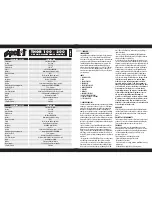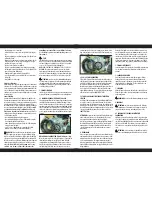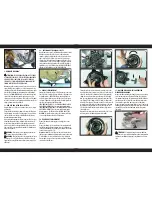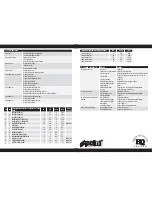
- Engine improper use or misusage;
- Assembly of parts or components not specified for the engine
use;
- Engine overheating or stop after long usage, beyond the term
indicated by Polini;
- Missing or irregular engine servicing as suggested by Polini, use
of improper petrol or oils, presence of dirty parts or foreign
bodies in the engine, even sucked;
- Engine overwork because overloaded;
- Engine or parts deterioration because of improperly storage;
- Faulty engine assembly, including the use of not original Polini
parts or coming from third parties;
- Damages to the engine caused by foreign bodies;
- Servicing operated by person outside Polini or by not authori
zed people;
- Competition use of the engine.
Final user obligations
Claims shall be done by delivering the engine to a Polini authori-
zed dealer. The user shall provide the original document that pro-
ves the purchasing or the warranty ticket authenticated by Polini
or by its distributor. To keep the validity of the warranty the user
shall carry out recurrent servicing according to the use and main-
tenance manual.
Limited liability
Pursuant to this warranty, Polini’s obligations are limited to the
defective parts reparation or, at its discretion, to change one or
more parts, necessary to remedy every malfunctioning caused by
defective materials or labor covered by the warranty. Polini or
the distributor can’t be held responsible for problems or damages
to persons/things/animals during the engine life.
We remind
you that this product is not certificated and it is only
dedicated to experimental aircraft
and that it can break or
suddenly stop working. No warranty or compensation are forese-
en for damages caused to:
- persons/animals/things during the engine use
- persons/animals/things caused by a collide with the propeller
or with parts detached from the engine
- frame, parts and/or propeller caused by the collide with parts
coming out from the engine
- costs for rescue, shipping, phone or rent after the collide,
problems or loss of time, or other indirect damages.
DANGER!
This not-certified engine can suddenly stop wor-
king. The engine stop can require emergency landings causing
injuries or death. The aircraft thrusts by this engine should fly in
open spaces only or during the daylight. The buyer assumes all
the risks for the use and he knows that by using it the engine can
suddenly stop working. This product is not covered by products
and public liability.
Who flies with a paramotor or only
switches it on assumes all the risks inherent to the
paragliding sport and all the responsibilities for dama-
ges to things or persons or death caused by the use of
this product.
2- FUEL
Thor 100/200 is a 2-stroke engine that needs oil/petrol mixture.
Only use good lead-free petrol purchased by a petrol station with
98 octane. Add good 2% synthetic oil to the petrol. It is possible
to use a 1,5% oil mixture with the following oils:
MOTUL 800 - CASTROL 242 - BARDAL KXT - ELF 976 - ELF 909.
WARNING: The nature of the carbon deposits on the cylinder
head, spark plug and exhaust port give important information
about the fuel mixture burning in your engine. Remember that
mixes that contain too much oil do not extend the engine’s life.
ATTENTION:
petrol is extremely inflammable and explosi-
ve. Carry out these operations in a well ventilate place and with
the engine switched off. Refrain from smoking and avoid all
naked flames or sparks where petrol is being drained or where
re-fuelling is being performed.
3- ENGINE STARTING
Start the engine only when all is in good conditions and perfectly
working. Furthermore check that all the nuts are well tightened.
3.1 WALBRO CARBURATOR (THOR 100-200)
First cold starting: fill in the fuel system using the pump provided
(carefully follow the instructions provided by the frame’s manu-
facturer to find out it and use it in the correct way). To make this
operation easier push softly with a finger the diaphragm through
the hole indicated by the arrow in photo 1. Fill it in till the petrol
reaches the carburettor. At that moment immediately stop; if you
go on acting on the pump the petrol will leak causing the engine
flooding.
01
WALBRO WG8 CARBURETOR (THOR 100 engine only)
:
Move the starter level to the off position (photo 1); now hand the
starter and start pulling the rope till it grows hard. Pull with
strength without accelerating till the engine seems to start wor-
king (do not repeat this operation more than 3 times otherwise
the engine may flood). Now move the starter lever to the on
position (photo 2) and act on the starting rope without accelera-
ting. If the engine doesn’t work with the first two attempts, try
again accelerating gently.
02
3.2 24/28 PWK CARBURETOR
Fill in the fuel system till the petrol reaches the carburetor hole
and then pump up three times (using the pump provided- Code
316.0016) to fill out the bowl. To start the engine pull upwards
the black level placed in the upper side of the carburettor.
Work the starter without accelerating till the engine start. Once it
works switch it off, disconnect the starter and start the engine
again slightly accelerating. For your safety only start the engine
after your harness has been COMPLETELY fixed!
3.3 THOR 200 ENGINE STARTING WITH ELECTRIC
STARTER
According to the carburettor model (Pwk or Walbro WB37) refer
to section 3.1 and 3.2 to fill in the fuel system. For the model
with electric starter the Polini throttle system has 3 buttons on the
bottom part of the throttle device. To start both the engines push
the black buttons together and slightly accelerate. For your safety
only proceed with this operation after your harness has been
COMPLETELY fixed!
ATTENTION
: keep the switch in your hand during all the stages
and be ready to work it in case of any anomaly. If necessary
keep it pressed till the engine has completely stopped.
Once the engine starts we suggest testing the right functioning of
the kill switch button. After having checked it, start the engine
again without accelerating and without using the starter. Now
start the engine and leave it idle until it warms up to normal
temperature.
4- RUNNING IN
Run your engine in as instructed below to ensure that the engine
and transmission bed in correctly and to ensure continuous relia-
bility in future. Once the engine starts, leave it idle until it warms
up to normal temperature. We suggest running the engine 15
minutes at medium-low engine power output gently accelerating
and with different intensity. Now we suggest checking the correct
idling calibration.
During the first flights or for the first 20 litres of petrol we sug-
gest not keeping the engine at the maximum rpm for too much
time, considering that the 2-stroke engine doesn’t stand to the
constant rpm even if of medium power. We suggest varying the
engine rpm. Check the carburetion after the first landing (section
6). Repeat the running in every time you change one of the fol-
lowing parts: piston, rings, cylinder, crankshaft or main bearings.
5- ENGINE SWITCING OFF
Switch the engine off by pressing the button till the complete stop
(see the frame manufacturer’s instructions to find the button
position)
6- CARBURETION CHECK
For a complete carburetion check switch the engine off after
having worked it for some minutes under load. Remove the
spark plug; unscrew it by using the proper key and verify that
the porcelain colour is light-brown. On the contrary, ask to an
authorized dealer for the calibration.
7- CLEANING
Clean the engine when it is switched off and cold to avoid burns.
Clean the engine with a soft cloth soaked with neutral cleansing
and non-aggressive.
WARNING:
Do not use acids that may damage the engine.
8-CARRIAGE
ATTENTION:
Carry the engine only when cold. Follow the
frame manufacturer’s instructions for its carriage. Be careful of
the petrol during the carriage; its leaking may cause a fire.
8.1 CARRIAGE OF THE ENGINE WITH PWK
CARBURETOR
PWK carburetor has a breather pipe studied to carry the engine
when lying. To empty the carburettor unscrew half turn the brea-
ther brass nut (highlighted in photo 3 with an arrow) and wait till
the fuel enters the tank. Close the brass connection again. Now
the carburettor is empty and you can lay the engine ready to be
carry.
ATTENTION:
never unscrew more than half a turn the bre-
ather nut to avoid damaging the OR seal. Never close too hard.























